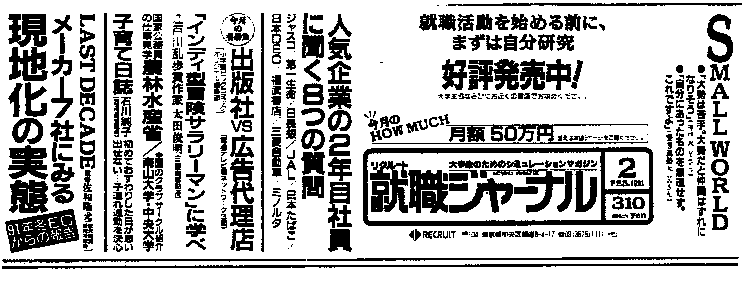In addition to Kanji, Hiragana, and Katakana, Japanese use the letters of the Roman alphabet, called Roomaji ('Roman letters'). Although the use of Roomaji is not widespread in Japan, it merits a chapter, if only because some Japanese and foreigners advocate discarding Kanji and Kana in favor of its exclusive use. There are even organizations that are dedicated to this cause, unlike in China and Korea.
The first romanization of Japanese was attempted by Jesuit missionaries
from Europe, such as Francis Xavier (15061552), who arrived in Japan
in 1549. ![]()
In modern Japanese writing, some European measurements, abbreviated,
are written in the Roman letters, as in cm and kg for centimeter
and kilogram. In technical writing, European words in Roomaji may
occur by themselves; or they may be accompanied by Kanji words for clarification.
![]()

Figure 20-1 is a Japanese advertisement for Recruit Journal , a magazine for a job market for university graduates, found in the newspaper Yomiuri (January 8, 1991). It contains the variety of scripts described in this Part III: Kanji, Hiragana, Katakana, Furigana, Roomaji, Arabic numerals, as well as a few English words. Note such English words as SMALL WORLD (written vertically), HOW MUCH (written horizontally), LAST DECADE (written at 90 degrees rotation); English acronyms such as JAL, EC, and DEC, and Japanese names referred to as Y-san and K-san; English loan words (e.g., simulation magazine, club circle) transcribed in Katakana; Arabic numerals for dates, prices, and house or phone numbers. The name of the journal in Japanese is shuushoku ('finding employment'), which has Furigana rikuruuto ('recruit'). This ad for a journal is typical of ads for other Japanese magazines in listing many and varied topics in the variety of scripts.
One wonders, Have English words conquered Japan?